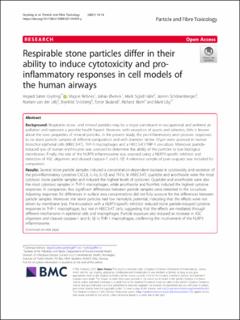| dc.contributor.author | Grytting, Vegard Sæter | |
| dc.contributor.author | Refsnes, Magne Arnold | |
| dc.contributor.author | Øvrevik, Johan | |
| dc.contributor.author | Halle, Marit Sigrid | |
| dc.contributor.author | Schönenberger, Jasmin | |
| dc.contributor.author | van der Lelij, Roelant | |
| dc.contributor.author | Snilsberg, Brynhild | |
| dc.contributor.author | Skuland, Tonje Schwach | |
| dc.contributor.author | Blom, Richard | |
| dc.contributor.author | Låg, Marit | |
| dc.date.accessioned | 2022-09-01T13:12:49Z | |
| dc.date.available | 2022-09-01T13:12:49Z | |
| dc.date.created | 2021-07-13T17:04:41Z | |
| dc.date.issued | 2021 | |
| dc.identifier.citation | Particle and Fibre Toxicology. 2021, 18 (1), 1-23. | en_US |
| dc.identifier.issn | 1743-8977 | |
| dc.identifier.uri | https://hdl.handle.net/11250/3015192 | |
| dc.description.abstract | Background
Respirable stone- and mineral particles may be a major constituent in occupational and ambient air pollution and represent a possible health hazard. However, with exception of quartz and asbestos, little is known about the toxic properties of mineral particles. In the present study, the pro-inflammatory and cytotoxic responses to six stone particle samples of different composition and with diameter below 10 μm were assessed in human bronchial epithelial cells (HBEC3-KT), THP-1 macrophages and a HBEC3-KT/THP-1 co-culture. Moreover, particle-induced lysis of human erythrocytes was assessed to determine the ability of the particles to lyse biological membranes. Finally, the role of the NLRP3 inflammasome was assessed using a NLRP3-specific inhibitor and detection of ASC oligomers and cleaved caspase-1 and IL-1β. A reference sample of pure α-quartz was included for comparison.
Results
Several stone particle samples induced a concentration-dependent increase in cytotoxicity and secretion of the pro-inflammatory cytokines CXCL8, IL-1α, IL-1β and TNFα. In HBEC3-KT, quartzite and anorthosite were the most cytotoxic stone particle samples and induced the highest levels of cytokines. Quartzite and anorthosite were also the most cytotoxic samples in THP-1 macrophages, while anorthosite and hornfels induced the highest cytokine responses. In comparison, few significant differences between particle samples were detected in the co-culture. Adjusting responses for differences in surface area concentrations did not fully account for the differences between particle samples. Moreover, the stone particles had low hemolytic potential, indicating that the effects were not driven by membrane lysis. Pre-incubation with a NLRP3-specific inhibitor reduced stone particle-induced cytokine responses in THP-1 macrophages, but not in HBEC3-KT cells, suggesting that the effects are mediated through different mechanisms in epithelial cells and macrophages. Particle exposure also induced an increase in ASC oligomers and cleaved caspase-1 and IL-1β in THP-1 macrophages, confirming the involvement of the NLRP3 inflammasome.
Conclusions
The present study indicates that stone particles induce cytotoxicity and pro-inflammatory responses in human bronchial epithelial cells and macrophages, acting through NLRP3-independent and -dependent mechanisms, respectively. Moreover, some particle samples induced cytotoxicity and cytokine release to a similar or greater extent than α-quartz. Thus, these minerals warrant further attention in future research. | en_US |
| dc.language.iso | eng | en_US |
| dc.publisher | BCM, Part of Springer Nature | en_US |
| dc.rights | Navngivelse 4.0 Internasjonal | * |
| dc.rights.uri | http://creativecommons.org/licenses/by/4.0/deed.no | * |
| dc.subject | NLRP3 inflammasome | en_US |
| dc.subject | Inflammation | en_US |
| dc.subject | Epithelial cells | en_US |
| dc.subject | Macrophages | en_US |
| dc.subject | Silica | en_US |
| dc.subject | Quartz | en_US |
| dc.subject | Stone particles | en_US |
| dc.subject | Mineral particles | en_US |
| dc.subject | Particulate matter | en_US |
| dc.title | Respirable stone particles differ in their ability to induce cytotoxicity and pro-inflammatory responses in cell models of the human airways | en_US |
| dc.type | Peer reviewed | en_US |
| dc.type | Journal article | en_US |
| dc.description.version | publishedVersion | en_US |
| dc.rights.holder | © The Author(s). 2021 Open Access This article is licensed under a Creative Commons Attribution 4.0 International License. | en_US |
| dc.source.pagenumber | 1-23 | en_US |
| dc.source.volume | 18 | en_US |
| dc.source.journal | Particle and Fibre Toxicology | en_US |
| dc.source.issue | 1 | en_US |
| dc.identifier.doi | 10.1186/s12989-021-00409-y | |
| dc.identifier.cristin | 1921622 | |
| dc.relation.project | Norges forskningsråd: 260381 | en_US |
| dc.source.articlenumber | 18 | en_US |
| cristin.ispublished | true | |
| cristin.fulltext | original | |
| cristin.qualitycode | 1 | |

